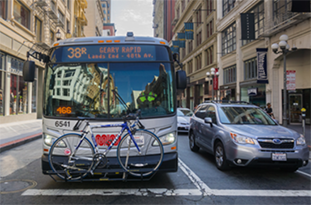Planning and Environment Linkages
PLANNING AND ENVIRONMENT LINKAGES (PEL) HYPOTHETICAL CASE STUDY:
ALTERNATIVES
View Printer-friendly
PDF
→
BACKGROUND
PEL is a valuable tool for creating efficiencies in the transportation project development process that supports agencies’ efforts to accelerate project delivery. PEL represents a collaborative and integrated approach to transportation decision-making that considers benefits and impacts of proposed transportation system improvements to the environment, community, and economy during the transportation planning process to inform the environmental review process.
This case study provides a hypothetical example of how the State Department of Transportation (DOT), West Sound Regional Council (WSRC), and the Metropolitan Planning Organization (MPO) for the West Sound region used PEL to identify a preliminary set of alternatives during the planning process that could be carried forward into the National Environmental Policy Act (NEPA) process.

The West Sound region is located between two mountain
ranges that support a diverse ecosystem. Source: 123RF
ENVIRONMENTAL CONTEXT
The geographic features of the West Sound region, located between two mountain ranges and bisected by its name-sake, make for a remarkable setting and support a richly diverse ecosystem. The region’s forests, wetlands, maritime waterways, and fisheries are natural resources that serve as key foundations for the region’s growing economy, and sustaining the environment is important for maintaining a high quality of life in the region. Although the region’s setting and resources make for an ideal location for a city, the topography limits lands suitable for development and imposes complex and often expensive infrastructure requirements.
PLANNING CONTEXT
PLAN2040, developed through a collaborative process among agencies and stakeholders, serves as the long-range growth management, environmental, economic, and transportation strategy for the West Sound region. It combines public commitment to environmental sustainability and regional growth management with the economic strength and efficient transportation facilities and infrastructure necessary to support that vision. It identifies the goals the community hopes to achieve by 2040, looks ahead to identify issues that could impede those goals, and strategizes ways to accommodate the projected job and population growth while preserving the natural environment.
Key themes shaping the community goals identified in PLAN2040 are environmental preservation, land use strategies, and sustainable transportation:
- Environmental Preservation: The region will care for the natural environment by protecting and restoring natural systems, conserving habitat, improving water quality, reducing greenhouse gas emissions and air pollutants, and addressing potential climate change impacts.
- Land Use Strategies: The region will focus growth within already urbanized areas to create walkable, compact, and transit-oriented communities that maintain their unique character.
- Sustainable Transportation: The region will have a safe, clean, integrated, sustainable, and highly efficient multi-modal transportation system that supports the regional growth strategy, promotes economic and environmental vitality, and contributes to better public health.
For many years, there has been discussion about growth and land use in the region, especially in the South Avenue corridor. The South Avenue corridor is experiencing commercial growth and development. Thus, congestion and transit reliability issues are worsening. In part due to the information in PLAN2040, the State DOT decided to form a PEL study team (consisting of the State DOT, the West Region Transit Authority, WSRC, Federal and state resource agencies, the Federal Highway Administration (FHWA), and the Federal Transit Administration (FTA)) that identified the purpose and need for a transportation improvement project in the South Avenue Corridor as addressing increased congestion by 2045, reliability, safety, increased travel demand due to population and employment growth, and insufficient multimodal system linkages.
Because there was a lack of information and clarity about potential alternatives, the PEL study team conducted a PEL corridor study during the transportation planning process, with the goal of determining the general modes of transportation.
PLANNING ACTIVITY
The PEL study team decided to use PEL to conduct a corridor study that fully integrates the transportation planning and the environmental review processes. The PEL study considered the conditions of the various PEL authorities early in the process to ensure that the information collected and decisions made could be used to inform subsequent environmental studies. The team worked to ensure the corridor study was sufficiently comprehensive, accurate, and integrated with the statewide and metropolitan planning processes, while engaging appropriate Federal and state resource agencies, Indian tribes, and the public in consultation, as appropriate. The PEL study team used a broad multidisciplinary consideration of systems-level or corridor-wide transportation needs.

The South Avenue corridor study included considerations
for bus routes and bike paths. Source: 123RF
Because work on the South Avenue corridor could affect the human and natural environment, and because the PEL study had not decided which PEL authority would be preferable, the team provided public notice that a multimodal team was undertaking the corridor study and that the products that would result from the study may be adopted during a subsequent environmental review process.
The corridor study focused on broad issues associated with various modes of transportation. The modes considered in this corridor study included:
- Expanding bus routes;
- Modifying existing transit routes into express routes;
- Extending light rail service;
- Constructing a subway;
- Establishing bus rapid transit;
- Establishing street car service;
- Expanding existing bike paths; and
- Widening existing highways.
The first phase of the corridor study used GIS data and other existing information to analyze the overall feasibility of improvements to the corridor. The feasibility analysis also included determining whether the regulatory (23 CFR 450.212(a)-(c) and 450.318(a)-(d) with the Appendix A of 23 CFR 450 guidance) or statutory (23 U.S.C. 168) approach to PEL should be used, taking into consideration the differing conditions for each approach. Although the regulatory approach would allow the corridor study to inform the project’s purpose and need statement and evaluation of preliminary alternatives, the statutory approach could be used in the planning process to fully develop the purpose and need and eliminate unreasonable alternatives, which could then be adopted and/or incorporated by reference during the subsequent environmental review process.

The study team conducted several public workshops as
part of the corridor study. Source: 123RF
The PEL study team thoroughly documented its evaluation criteria, coordination, and planning product decisions. The results of the first phase of the corridor study were made available for public review and comment through several public workshops, and any comments received were documented for the next phase.
In the second phase of the corridor study, the PEL study team seamlessly continued public involvement and coordination. They performed a more detailed analysis of the corridor conditions, existing issues, and possible modal solutions. The PEL study team requested and held a coordination meeting with environmental, regulatory, and resource agencies with jurisdiction within the study area, to consider and concur on the purpose and need for the project. The PEL team also coordinated with federally recognized tribes.1 The PEL study team included local jurisdictions and major modes of transportation as a subcommittee. The agencies represented included the U.S. Army Corps of Engineers, the U.S. Environmental Protection Agency, the U.S. Fish and Wildlife Service, the U.S. Forest Service, and the state historic preservation office. The PEL study team continued to sufficiently document the analysis criteria and process, as well as the input received from the coordination meetings.
POSSIBLE OUTCOME #1
The South Avenue corridor project remained a fully funded, high priority project, as part of the transportation planning process (and followed the 23 U.S.C 139(f)(4)(E) and 23 U.S.C. 168 approaches).
During the transportation planning process, the PEL study team used the purpose and need established during the corridor study and concurred upon by the environmental, regulatory, and resource agencies to move forward with identifying transportation modes as preliminary alternatives and eliminating unreasonable alternatives. The PEL study team wanted to allow for the adoption of planning products (i.e., purpose and need, preliminary identification of alter-natives, and elimination of unreasonable alternatives) from the corridor study directly into the NEPA document during the targeted two-year environmental review schedule. Because the corridor improvements remained a priority to local decision makers, the PEL study and the resource agencies were fully engaged and agreed to cooperate during planning the planning process. Both the PEL study team and the resources agencies decided that they were willing and able to meet and achieve the conditions of the 23 U.S.C. 168 and 23 U.S.C 139(f)(4)(E) approaches.
The PEL study team included a multimodal team that ensured that the purpose and need and elimination of unreasonable alternatives were developed and fully integrated into the transportation planning process.2 By following this process, the existing WSRC planning processes could be used in the subsequent environmental review process. This process included freight, bicycle and pedestrian, and broad multidisciplinary analysis and subcommittee input to incorporate consideration of systems-level or corridor-wide transportation needs and potential effects.
The PEL study team was able to eliminate unreasonable alternatives, such as construction of a subway and establishment of bus rapid transit, because they did not meet the established purpose and need. The elimination of unreasonable alternatives analysis during the corridor study was documented in sufficient detail to support the decision to move forward with alternatives for expansion of pedestrian and bike paths, highways, street car routes, and bus routes. These multimodal alternatives all met the purpose and need and responded to the various constituencies involved in the project corridor, setting the stage for a thorough alternatives analysis in the subsequent environmental review that weighed each alternative in a fair and balanced manner. All analyses or studies used to eliminate alternatives from detailed consideration were made available to the public and participating agencies during the NEPA scoping process and were reasonably available during comment periods. Upon initiation of the environmental review process the project sponsor coordinated with FHWA/FTA for publication of the Notice of Intent (NOI) in the Federal Register. The NOI announced the preparation of a NEPA document for the project that would include the limited alternatives. Having met the requirements of 23 U.S.C. 139(f)(4)(E), the lead agency adopted the analysis and decisions documenting the elimination of alternatives.
POSSIBLE OUTCOME #2
The South Avenue corridor project lost funding due to changing priorities and was delayed to later program years (using the 23 CFR 450.212(a)-(c) and 450.318(a)-(d), with the Appendix A of 23 CFR 450 guidance, approach).
Due to the high cost of some of the alternatives proposed, the project is no longer considered high priority project during the transportation planning process, and some of its funding has been subsequently reallocated to other projects. Further, the PEL study team was unable to gain internal consensus on the project’s purpose and need. However, the PEL study team determined that a more detailed study was necessary to move forward to identify modal alternatives and eliminate unreasonable alternatives. The additional study has helped to identify a reasonable range of alternatives to solve the noted transportation challenges and potentially regain support for the project so that it could be programmed for funding.
The PEL study team wanted to incorporate by reference or use the documents produced from the South Avenue corridor study into the subsequent environmental study. The planning products from the corridor study would inform the purpose and need, and support the elimination of unreasonable alternatives (or the preliminary identification of alternatives) in the NEPA document.
The PEL study team and resource agencies agreed that the regulatory approach would be beneficial for the project because it would allow for early analysis to further develop the purpose and need that could be used to inform and support identification of alternatives and modes.3 Planning products from the corridor study could also be incorporated by reference to support the elimination of unreasonable alternatives during NEPA.
The agencies agreed that the project would not be able to move forward without additional information, such as more in-depth knowledge about the project need, the depth of public controversy or public commitment to environmental sustainability and regional growth management, and how this affected the project alternatives. Further analysis was needed to determine if there was sufficient economic growth to support the different pro-posed future transportation facilities. The PEL study team needed additional performance management data and analysis that would contribute to establishing or evaluating the purpose and need and reasonable alternatives based on regional system performance.
The PEL study team provided the public with ongoing opportunities to review the progress of the corridor study with a reasonable opportunity to comment, which was integrated into the metropolitan transportation planning process. Because of the rapid growth on the corridor, sufficient and comprehensive documentation of land use decisions was also needed. The PEL study team determined that these should be documented in a form that would be identifiable and available for review during the NEPA scoping process. The PEL study team committed to documenting the analysis in a manner that allowed for direct reference in the NEPA process. This was accomplished with FHWA’s and FTA’s continued oversight and review of the information.
During NEPA, the lead agency for the project ensured that all the documents for the analysis of elimination of alternatives, that were to be incorporated by reference were ‘‘reasonably available for inspection by potentially interested persons within the time allowed for comment.’’4 All analyses or studies were made available to the public and participating agencies during the NEPA scoping process and were reasonably available during comment periods. Incorporated materials were cited in the NEPA document and their contents briefly described, so that the stakeholders and the public reviewing the documents could understand why the document was being cited and knew where to look for further information. To the extent possible, the documentation included official actions such as decisions by the MPO, State DOT, or public transportation operator and/or correspondence within and among the organizations involved in the transportation planning process regarding major modes of transportation.5
2 23 U.S.C. 134 and 135, and implementing regulations at 23 CFR Part 450.
3 23 CFR 450.212(a)-(c) and 450.318(a)-(d) and Appendix A of 23 CFR Part 450.
5 See, e.g., Appendix A of 23 CFR Part 450.
DISCLAIMER: Except for the statutes and regulations cited, the contents of this document do not have the force and effect of law and are not meant to bind the public in any way. The document is intended only to provide clarity to the public regarding existing requirements under the law or agency policies.

